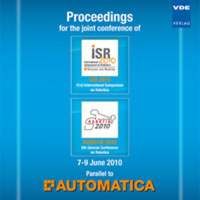Flexible Assembly Systems through Workplace-Sharing and Time- Sharing Human-Machine Cooperation (PISA)
Konferenz: ISR/ROBOTIK 2010 - ISR 2010 (41st International Symposium on Robotics) and ROBOTIK 2010 (6th German Conference on Robotics)
07.06.2010 - 09.06.2010 in Munich, Germany
Tagungsband: ISR/ROBOTIK 2010
Seiten: 5Sprache: EnglischTyp: PDF
Persönliche VDE-Mitglieder erhalten auf diesen Artikel 10% Rabatt
Autoren:
Krüger, Jörg; Katschinski, Volker; Surdilovic, Dragoljub; Schreck, Gerhard (Fraunhofer Institute for Production Systems and Design Technology (IPK), Pascalstraße 8-9, 10587 Berlin, Germany)
Inhalt:
In September 2006 an integrated European project (IP) was launched entitled "Flexible Assembly Systems through Workplace-Sharing and Time-Sharing Human-Machine Cooperation (PISA)". The general aim of the project is to develop intelligent assist systems (IAS) in order to support the human worker instead of replace him. The project comprises nine interrelated subprojects and has an overall duration of 48 months. It involves four large companies, seven SMEs, and seven research institutes from seven European countries. One breakthrough of this project is to fill the gap between manual and automated assembly by introducing novel IAS technology and providing planning and integration tools to make this new technology applicable. A second breakthrough is to achieve the reconfigurability of assembly systems and the reusability of assembly equipment. On the one hand, this is related to a modular structure of assembly systems, including standard hardware- and software-interfaces of assembly equipment. On the other hand, methods and tools are needed for reconfiguration planning, re-programming, life-cycle and equipment management, and knowledge bases for assembly solutions. The aim of the project is their prototypical development, including demonstrations based on industrial use-cases. The main technological developments have been performed during the first 36 month of the project. This means prototype systems are already available, and will be further adapted to demonstrators for industrial use-cases in the last year of the project.


